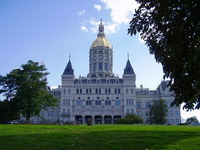Login form
Connecticut

Connecticut is nicknamed the Constitution State. Connecticut had a written constitution in 1639, before any other colony in North America. This document set down the rules for governing the colony. Connecticut claims it was the first written constitution in the world.
QUINNEHTUKQUT
Connecticut is the third smallest state in the United States. Only Rhode Island and Delaware are smaller. The name Connecticut comes from a Native American word, Quinnehtukqut. It means “beside the long tidal river.” That river is the Connecticut River. It flows through the middle of the state, from north to south.
|
Facts About Connecticut |
|
|
|
|
|
Capital |
Hartford |
|
Population |
3,480,000 people |
|
Rank among states in population |
29th |
|
Major cities |
Bridgeport, New Haven, Stamford |
|
Area |
5,540 square miles |
|
Rank among states in area |
48th |
|
Statehood |
January 9, 1788, the 5th state |
|
State nickname |
The Constitution State |
|
Name for residents |
Connecticuters |
|
State bird |
Robin |
|
State flower |
Mountain Laurel |
|
State tree |
White Oak |
|
Abbreviation |
CT |
After splitting the state, the Connecticut River empties into Long Island Sound, a part of the Atlantic Ocean. The sound borders Connecticut on the south. Rocky inlets, bays, sandy beaches, and saltwater marshes are along the sound.
Connecticut was one of the 13 American colonies. On January 9, 1788, it became the fifth state to join the United States. Hartford is the capital. Bridgeport is its largest city.
HARTFORD
Hartford is located on the Connecticut River. So many insurance companies did business from Hartford that it became known as the Insurance Capital of the World. Hartford started selling insurance in the 1790s to protect people financially against losses from fire and other disasters.
Mark Twain lived in Hartford from 1874 to 1891. This is where he raised his family and wrote many of his famous books, including The Adventures of Huckleberry Finn. Twain’s neighbor was Harriet Beecher Stowe, another important writer of the 1800s. Stowe awakened Americans to the evils of slavery with her book Uncle Tom’s Cabin. Today, you can visit Twain’s house and Stowe’s house in Hartford.
Dinosaur State Park is in Rocky Hill, near Hartford. You’ll see hundreds of fossil footprints made by dinosaurs 185 million years ago. You’ll also see the kinds of plants that lived when the dinosaurs did. They grow in the park.
BRIDGEPORT
Bridgeport, Connecticut’s largest city, is a manufacturing center. Bridgeport hosts a Barnum Festival every year to celebrate the city’s history and a former mayor, showman P. T. Barnum. Barnum was a circus producer in the 1800s. He had animals in his circus. He also put Siamese twins and a midget named Tom Thumb on display. Barnum called his circus “The Greatest Show on Earth.” You can visit the Barnum Museum in Bridgeport.
COLONIAL TIMES AND WHALING DAYS
Connecticut is a good place to visit America’s past and learn about colonial times. Many towns still have well-maintained houses from colonial days. At the center of town, there’s usually an open, grass-covered area called the village green. A graceful church with a tall, white steeple typically stands along the green.
Some Connecticut towns along Long Island Sound were whaling ports in the 1800s. Whaling boats set out from Mystic Seaport and New London. People hunted whales for oil and whalebone. They made candles from whale oil and also burned the oil in lamps. From whalebone, they made hoops for women’s wide skirts and other products. At the Mystic Seaport museum, you can see ships from whaling days and old houses and shops.
A SELF-GOVERNING COLONY
The colony of Connecticut was formed in 1639. The colonists adopted a set of laws called the Fundamental Orders. This was Connecticut’s constitution, and it made the colony largely self-governing. The constitution ignored the authority of the king of England.
THE CHARTER OAK
In 1662, King Charles II of England granted Connecticut a royal charter. The charter approved the system of government in the Connecticut Colony. After Charles II died, the new king tried to take away Connecticut’s self-rule. He demanded that Connecticut surrender the charter. But the charter disappeared.
Legend has it that the colonists hid the charter in a large, hollow oak tree. This tree came to be called the Charter Oak. The Connecticut commemorative quarter carries a picture of the Charter Oak.
THE ARSENAL OF THE NATION
Connecticut has poor soil for farming, and so the state developed industries early. The people of Connecticut were clever at making things. Connecticut produced nails, hats, clocks, and guns in the late 1700s.
Connecticut is sometimes called the Arsenal of the Nation because of the weapons it produces. Weapons made in Connecticut helped the Americans to win independence from Britain during the American Revolution (1775-1783). In the 1800s, Samuel Colt invented the revolver and set up a gun factory in Hartford. Oliver Winchester made rifles in New Haven, Connecticut.
In the 1900s, Connecticut supplied firearms for World War I and World War II. The U.S. Navy launched the first nuclear-powered submarine from a Connecticut shipyard in 1954. Today, the state makes guns, helicopters, airplane engines, submarines, radar, and other equipment for the U.S. military.
HOME OF INVENTORS
Connecticut has been home to many inventors besides Colt and Winchester. Eli Whitney is the state’s most famous inventor. His cotton gin made cotton the most important crop in the American South. In 1798, he set up a factory in Hamden, Connecticut, to make guns. His system of mass production changed manufacturing.
In 1839, Charles Goodyear of Naugatuck, Connecticut, accidentally dropped some rubber on a stove. The heat turned the soft, gummy rubber into a strong, hard rubber that could be used to make things. Heat-hardened rubber is used today in car tires, shoes, and blimps.
Source: Microsoft ® Encarta

